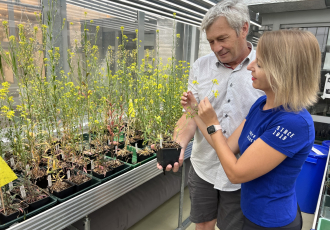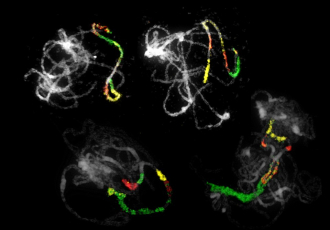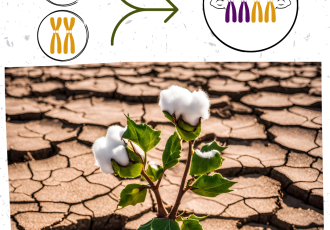24. Sept. 2024
Entering the world of scientific research can feel like navigating a complex maze, where every path leads to a new hidden discovery. This sentiment was echoed in our interview with Terezie Mandáková from CEITEC, a research institute of Masaryk University, and Aleš Kovařík from the Institute of Biophysics of the Czech Academy of Sciences. Together, we ventured into the intricate world of plant genetics, exploring the inner workings of cells. Our discussion touched on how plant research can address global challenges, and how humour and open-minded approach help them cope with the heavy demands that research places on their personal lives. We also explored the role of diversity in research and, naturally, asked whether they ever talk to plants.
Some growers talk to their plants. Beyond the psychological impact on humans, does this also affect plants? Do you also talk to plants in the lab?
Terezie Mandáková (TM): While plants likely don't “hear” words the way we do, they are sensitive to their environmental, including sound. Research has shown that sound vibrations can influence plant growth. For instance, studies suggest that exposing plants to certain sound frequencies can stimulate their development. Sounds akin to human conversation may promote fluid movement within plants, potentially benefiting their metabolism. As for me, do I talk to them? Well, sometimes I sing in the lab (laughs). It lightens the mood and creates a more relaxed atmosphere.
Aleš Kovařík (AK): You observe them more closely, checking on how they're doing, and you strive to provide the best possible conditions. This added care definitely has a positive effect on plant health. It's similar to raising children – the more time, love, and attention you give them, the better the outcome. So, from both a scientific and psychological perspectives, it's a lovely way to connect with nature.
It seems that the combination of feminine and masculine elements in your research partnership works remarkably well. What makes you such effective collaborators?
TM: What truly enhances our project is how our different perspectives enrich our work. It's not about whether the team is exclusively male, female, or mixed – what matters is maintaining an open mind and welcoming diverse opinions. This approach fosters team energy and creativity. While we sometimes feel pressure to boost the number of women in projects at all costs, I believe research should not focus on quotas. Ultimately, it's the talent and skills each individual brings to the team that lead to innovative outcomes.
AK: We have been working together for several years, and we complement each other perfectly, despite the generation gap. The younger CEITEC team brings knowledge of modern technologies and innovative methods, while I contribute experience and best practices. This blend of youth and experience creates unique opportunities for research development. For instance, when we worked on a project funded by the Czech Science Foundation (GACR), this dynamic proved highly effective. We successfully secured two grant projects and are currently working on another.
Both of you are involved in joint research on hybrid and allopolyploid plants. I understand that a hybrid plant is an offspring resulting from the crossing of two different species or varieties, but what exactly is an allopolyploid?
AK: Generally, hybrids tend to be infertile. A classic example is the mule or the hinny, which are crossbreeds between horses and donkeys. While these hybrids are strong and vigorous, they cannot produce offspring. This is where allopolyploidy comes into play, as it can ensure the fertility of hybrids, potentially leading to the creation of new species. In a typical hybrid, the offspring receives one set of chromosomes from each parent. In contrast, an allopolyploid has duplicated sets, meaning it has two complete sets of chromosomes. This "double dose" of genetic material often gives plants unique characteristics. A prime example is wheat, which results from crossing three different grass species, leading to six sets of chromosomes. This genetic complexity contributes to wheat’ greater resistance and improved growth traits.
What exactly are you focusing on with hybrid and allopolyploid plants?
TM: We're interested in how their genes change and adapt. We study the mechanisms that influence the function of ribosomal DNA and ribosomes. In simple terms, we examinate how genetic differences between the parent plants are expressed in allopolyploids and how this impacts ribosome formation and the plants' adaptability to various conditions. Our research contributes to better understanding of plant evolution, the origin of new species, and the factors that influence their genetic diversity.
How are ribosomes and ribosomal DNA related?
TM: Imagine that in every cell, whether in your body or in plants, there is a little factory that constantly produces the essential building blocks – proteins. This factory is called a ribosome. To function properly, ribosomes need instructions, and that's where ribosomal DNA, or rDNA, comes in. It serves as a library that stores the blueprints ribosomes use to assemble proteins.
AK: We recently published a paper in The Plant Journal exploring why nature has provided these factories with two different types of blueprints and the significance of each. While we know quite a bit about 35S rDNA, the 5S rDNA we study remains largely a mystery, particularly in hybrid and allopolyploid plants where the genomes of different species are combined.
How do you unravel this mystery, and what have you found in your research?
TM: Our research focuses on three species of bittercress, a meadow plant that serves as a "lab mouse" for our studies. We have discovered something akin to a revolution in the ribosomal factory. Imagine two factories producing similar products merging to create innovative new ones, using the best components from both. In allopolyploid plants, the genetic materials from both parent species combine to form what we call chimeric ribosomes. Interestingly, during this process, some genes are often "switched off". This likely happens because the cell needs to simplify its genetic makeup and stabilise its functions.
AK: When a cell receives multiple copies of the same or similar genes during hybridisation or polyploidisation, it can lead to overload and unbalanced activity. This is where epigenetic regulation comes into play, helping cells avoid issues like overproduction of molecules or malfunctioning cellular processes. By silencing certain genes, plants can more effectively process genetic information from both parents and adapt to new conditions.
Gene switching likely did not emerge overnight; rather, it is probably an integral part of plant evolution. What are the implications for the plant kingdom?
AK: The implications are significant. Gene silencing acts like a silent conductor, guiding how a plant responds to environmental changes. It can silence genes from one parent while activating genes from the other, allowing the plant to optimize its adaptability in a given environment. This process can even cause different populations of the same species to activate or silence distinct combinations of genes, ultimately leading to genetically unique lineages. Such mechanisms promote evolutionary diversification and can lead to the origin of new species that are better adapted to specific conditions.
Listening to you, it seems almost impossible to fit research into a standard eight-hour workday. How do you manage to juggle your demanding scientific work with your personal life?
TM: The key is balance and effective time management. When science is also your hobby, you find joy in it, which helps recharge you during challenging moments. However, it's crucial to maintain clear boundaries between work and personal life, set priorities, and sometimes even laugh at your own mistakes. Humour and perspective, in my opinion, are essential for success and satisfaction both at work and at home.
AK: I completely agree with Teri. However, like any hobby, a passion for science must be tempered. If you become overly zealous, you can easily get lost in research that leads nowhere. Having a strong background in family, engaging in cultural activities, or participating in sports not only provides balance, but also fosters important self-reflection that helps clarify what truly matters. For instance, I love volunteering at a kids' summer camp; it reminds me that the challenges at work aren't as overwhelming as they may seem. Conversely, a scientific approach can enhance your ability to critically evaluate information in the media and on social networks.
Most people don't find plant research as attractive as, say, developing a cure for cancer. What draws you to the study of plants?
TM: Plants are literally the cornerstones of life on Earth. Without them, we wouldn't have food or oxygen. Plant research is vital for our future because it helps us understand how to ensure food security and protect the environment. What many people may not realize is that many medicines, including those for cancer, are derived from plants, which provide essential raw materials for the pharmaceutical industry. Thus, studying plants is not only fascinating but also crucial for sustaining life on Earth.
AK: Our work is a piece of a mosaic that reveals the bigger picture of how plants function and how they can help address global challenges. We study how ribosomes and genetic diversity enable plants to survive and thrive even in extreme conditions. This research is essential for developing crops that can meet challenges like climate change and food security for a growing population. Additionally, we recognise that our research intersects with other fields; for instance, we know that ribosomes in cancer cells differ from those in healthy cells, which could lead to more targeted cancer treatments. Ultimately, our work offers hope that we may one day discover plants with remarkable properties that we can hardly predict today. That's what keeps us moving forward.


 Share
Share








